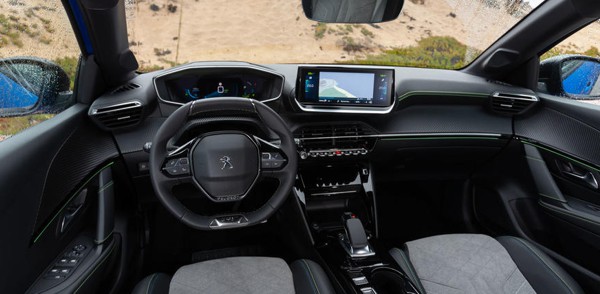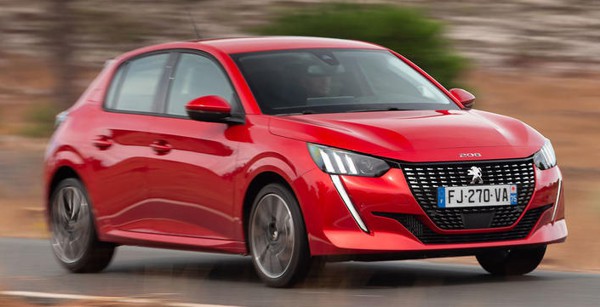Published
on 25
Feb 2020
|
All rights reserved.
|
|
|

|
|
A
reborn 205 might be overstated, but the new 208 has enough charms to
catch the majority of buyers.
|
|
People say the second
generation 208 is Peugeot’s best effort to repeat the success of 205,
that legendary small car that beat all rivals in the 1980s and early
1990s. Frankly, the new 208 doesn’t drive as good. Its handling is not
as sharp, its steering not as communicative, and its rear axle not
quite as interactive to throttle. Admittedly, none of the current
superminis could match the 205 for driving thrills either, because
modern
buyers
have their interest shifted to refinement, comfort and safety. Car
makers did not kill fun-to-drive superminis, but car buyers do.
Peugeot started following this “modern” trend from the 206 and reached
a peak in 207, which was heavy, slow and numb. To a certain degree, the
last 208 returned to form, as it got smaller, lighter and a bit more
sensitive to driver input. We loved the outgoing 208 GTi by Peugeot
Sport especially, but the cooking models were less distinctive when
compared with Ford Fiesta, Seat Ibiza and VW Polo. Everybody agrees
that the Ford is the sharpest and most fun to drive. It also has a
remarkable powertrain in the form of 1.0 Ecoboost. Polo is the most
refined, the best built and one of the most practical. In between lies
its sister car Ibiza, which is fun enough to drive yet practical for
your everyday life. These 3 cars cover all kinds of needs and taste.
Directly or indirectly engineered by Germany, they declared the victory
of German-school in the supermini segment.
However, what they fail to do is to stir your desire. French car makers
are much better in this respect. The original Renault 5 and Peugeot 205 caught the hearts of car
lovers by a pretty look, which is so lacking in the current generation
of superminis. You might say Fiesta and Ibiza look sharp, Nissan Micra
and Mazda 2 look radical, or a Mini look cute, but stylish does not
mean beautiful. Beautiful is something you appreciate with your basic
instinct, no need to educate, no need to get used to. You know you fall
in love with the R5 and 205 in the first sight, but a Fiesta? Not so
sure. The French duo got classic status also because of many other
factors, but first and probably the most important of all, their looks
catch your soul.
 |
|
It
is just like winding backward from Countach to Miura, from a space-age
nonsense to a classical yet more beautiful proportion, so refreshing to
eyes.
|
|
The new 208 is the same. Its appearance makes you wow. It is difficult
to explain why, but it just brings back the wow factor lost so long in
the supermini segment. The 208 has neither the very sharp nose of
Fiesta, nor the aggressive headlamps of Ibiza, nor the GT-R grille of
Micra. It even lacks the sharp body profile of its predecessor.
Instead, it returns to a classic proportion – a flatter bonnet, a more
upright windscreen, a less sweeping waistline hence larger glass area –
just like a 205. More crucially, it gets a thicker, triangular-shape
C-pillar like that classic model. Somehow, the rationalized silhouette
is easier on the eyes. It is just like winding backward from
Lamborghini Countach to Miura, from a space-age nonsense to a classical
yet more beautiful proportion, so refreshing to eyes. The new 208
doesn’t have any sharp crease lines, something being so abused by
modern car designers to build character into their cars. Instead, its
body is smooth, with subtle curves hence a high sense of refinement.
Through these curves, also the stylishly patterned grille and the long
LED light stripes extended from the headlights, the 208 avoids the
blandness of its bigger brother 308. This could be the most successful
Peugeot
design since the 406 Coupe.
Inside, the delight continues. The 208 Mk2 is not exactly a spacious
small car. In fact, its rear seats are no more than average, adequate
to take sub-six-footers but never for a long trip. That’s fine,
considering a supermini is not supposed to match a C-segment car. What
it really shines is the cabin’s styling and build quality. The
materials, whether the leather on steering wheel, the faux carbon-fiber
trims on dashboard, the lacquered treatment on center console and the
soft-touch plastics in essential areas, are top-notch, putting
Volkswagen Polo or even Mini in shade. The dashboard is not lack of
style either. It is curved towards the door panels, shaped in a 2-tier
architecture so to feel more spacious and less bland than the usual
supermini dashboard. Peugeot’s unique small steering wheel and an
instrument pod that is mounted above the wheel rim are carried over
from the old car, but they get even more stylish. Admittedly, they take
some getting used to, and the rim could block the instrument reading
for shorter drivers. Still, they make the Peugeot’s driving environment
special, more so than the one-spoke steering wheel first found on
Citroen DS.
 |
|
Top notch
styling and build quality puts even Volkswagen in shade.
|
|
The instrument is another highlight. It is not only a reconfigurable
digital display, but it displays information in 2 layers, like a
hologram. Very stylish, if not actually useful. On the center console,
the touchscreen (7-in as standard or 10-inch on higher trim levels) is
angled towards the driver for easier reading. The software of
infotainment system is not quite
as intuitive to use as the alternatives from VW group or Ford, but at
least the display is clear and responsive. There are piano-style
short-cut keys located below the touchscreen for easier access to some
functions, but adjusting the air-con still needs to go through the
menus, which is annoying. On the plus side, connectivity is strong,
while upmarket safety features like adaptive cruise control, lane
keeping and automatic parking are provided. Moreover, the front seats
are excellent, both supportive and comfy.
The new 208 is built on the new CMP (Common Modular Platform), first
introduced by DS3 Crossback. It is PSA group's small car platform,
covering B and C-segment models. The CMP's biggest advantage is the
compatibility with alternative power, including pure electric
powertrain. This is a first for a mainstream European supermini. While
rivals like Renault Zoe and Honda E (as well as the larger Chevrolet
Bolt and VW ID3) ride on dedicated “skateboard” EV platforms, the CMP
has a more conventional structure. Its battery pack is integrated with
the floorpan, but locating underneath the front and rear seats, taking
the space left by fuel tank and exhaust. This means the occupants sit
lower, as in conventional cars. The electric motor and power
electronics are located under the bonnet and drive the front wheels.
This allows the e-208 to share as much parts as possible and to be
built on the same assembly line as other 208s, saving enormous
production costs. Meanwhile, the battery does not intrude into the
cabin or boot, so both passenger and luggage space are unchanged. The
only modifications necessary are a redesigned torsion-beam rear axle to
accommodate the wider battery, some reinforcement in subframe and
stiffened suspensions to cope with the extra weight of
about 300 kg. Otherwise, the electric version is almost the same as
other 208s, inside and outside.
 |
|
Superb PureTech
engines provide brisk performance. Electric powertrain even more so.
|
|
The electric motor generates 136 hp and a useful 192 lbft of torque,
enabling the e-208 to sprint from rest to 60 mph in merely 7.6 seconds.
It is actually the fastest accelerating 208 until the upcoming GTi,
although its top speed is limited to 93 mph. As in most EVs, the e-208
feels brisk on the road, especially in urban area thanks to its instant
torque. You may choose between 2 levels of regenerative braking. Pedal
feel is not quite the most linear but not too bad either. The battery
has a respectable capacity of 50 kWh, far more than the 32.6 kWh of
Mini SE or 35.5 kWh of Honda E, giving it a WLTP range of 340 km (211
miles). That makes it far more useable than those cars and good enough
for the majority of buyers to consider. Meanwhile, the Peugeot costs
about the same to buy, which means great value for money considering
its good look and premium build quality.
At the conventional side, all gasoline-powered 208s employ the
1.2-liter PureTech 3-cylinder engine in various state of tune: 75 hp
for naturally aspiration, 100 hp or 130 hp for turbocharging. The
former is underpowered and best to be avoided. The 100 hp turbo is the
sweet spot, offering superb refinement, sufficient performance, good
flexibility and remarkable fuel efficiency at a reasonable cost.
Moreover, it is available with both the 6-speed manual or 8-speed
automatic, although gearshift of the former is a bit rubbery. The 130
hp version is quick, with performance resting in “warm hatch” category.
8-speed automatic is compulsory, but it is a superb gearbox, with
smooth and responsive gearshift and 8 ratios to keep fuel economy high.
All PureTech engines are smooth and eager to rev. They are slightly
less lively than Ford’s 1.0 Ecoboost, but make up for more torque and
a calmer operation. On the diesel side, there is only a 100 hp 1.5
BlueHDi to soldier on, as diesel is falling out of favour due to the
surging cost for cleaning up pollution. That is also why the 208 has to
introduce an electric powertrain.

|
|
Chassis
majors on refinement, but troubled by flawed ride and steering.
|
|
The new 208 is 93 mm longer and 6 mm wider than before, but a good 30
mm lower, while the 2540 mm wheelbase is unchanged. Peugeot claims a
kerb weight reduced by 30 kg. Somehow, we found the opposite is true.
On the road, the small Peugeot majors on refinement. The PureTech turbo
engine is hushed at motorway speed. The wind and road noise very well
suppressed. The ride is also good on highway, making it is a very
comfortable small car to run long trips. However, when the road gets
coarser and twistier, it is not so good. The soft suspension leads to
more body roll than keen drivers would like. The light and tiny
steering, while being handy in urban driving, feels numb, giving little
information on the front-end grip. Meanwhile, potholes and sharper
bumps could unsettle the ride, revealing a lack of suspension travel or
inadequate damping. This is especially poor on the stiffly-sprung
e-208. On petrol-powered models, choose the smaller 16-inch wheels will
solve the problem mostly, but still, it does not ride as good as VW
Polo. On the other hand, handling and steering feel are quite a long
way behind Fiesta, Ibiza or Mazda 2, even though the car does display
predictable handling and dependable grip.
If this problem is sorted out, we would no doubt give the Peugeot the
highest recommendation and declare the rebirth of 205. As it is, the
208 Mk2 is still a highly desirable package. Gorgeous, superbly built,
classy, generally refined and offered with some excellent engines, it
satisfies most people’s need. Keener drivers will still choose a Fiesta
instead, but others would be stupid not to consider the 208 before
making their purchasing decisions.
|
Verdict:     |
|